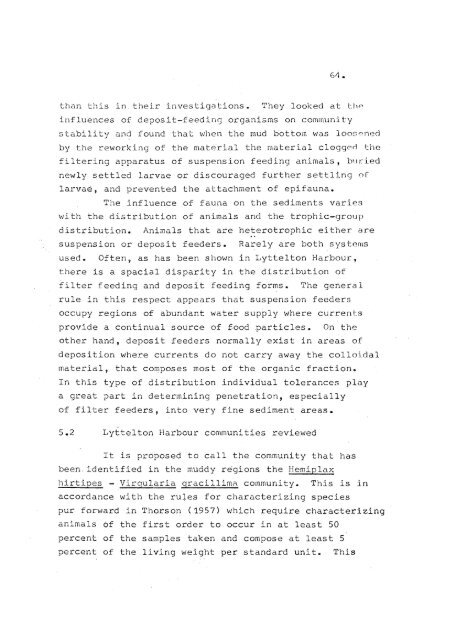The benthic ecology and community structure in Lyttelton Harbour ...
The benthic ecology and community structure in Lyttelton Harbour ...
The benthic ecology and community structure in Lyttelton Harbour ...
You also want an ePaper? Increase the reach of your titles
YUMPU automatically turns print PDFs into web optimized ePapers that Google loves.
than th <strong>in</strong>. their <strong>in</strong>vestigations. <strong>The</strong>y looked at tl10<br />
<strong>in</strong>flu~nces<br />
of deposit-feed<strong>in</strong>g organisms on <strong>community</strong><br />
stability an~ found that wl1en the mud bottom was loosr~ned<br />
by the rework<strong>in</strong>g of the material the material clogqerl the<br />
filter<strong>in</strong>g apparatus of suspension feedi~g animals, blJr'ied<br />
newly settled larvae or discouraged further settl<strong>in</strong>g of<br />
larva~,<br />
<strong>and</strong> prevented the attachment of epifauna.<br />
<strong>The</strong> <strong>in</strong>fluence of fauna on the sediments varies<br />
with the distribution of animals <strong>and</strong> the trophic-group<br />
distribution. Animals that are heterotrophic either are<br />
suspension or deposit feeders. Rarely are both systems<br />
used. Often~ as has been shown <strong>in</strong> <strong>Lyttelton</strong> <strong>Harbour</strong>,<br />
there is a spacial d parity <strong>in</strong> the distribution of<br />
filter feed<strong>in</strong>g <strong>and</strong> deposit feed<strong>in</strong>g forms. <strong>The</strong> general<br />
rule <strong>in</strong> this respect appears that suspension feeders<br />
occupy regions of abundant water supply where currents<br />
provide a cont<strong>in</strong>ual source of food particles. On the<br />
other h<strong>and</strong>, deposit feeders normally exist <strong>in</strong> areas of<br />
deposition where currents do not carry away the colloidal<br />
material, that composes most of the organic fraction.<br />
In this type of distribution <strong>in</strong>dividual tolerances play<br />
a great part <strong>in</strong> determ<strong>in</strong><strong>in</strong>g penetration, especially<br />
of filter feeders, <strong>in</strong>to very f<strong>in</strong>e sediment areas.<br />
5.2 <strong>Lyttelton</strong> <strong>Harbour</strong> communities reviewed<br />
It is proposed to call the <strong>community</strong> that has<br />
been. identified <strong>in</strong> the muddy r~gions the Hemiplax<br />
hirtipes - Virqularia gracillimR <strong>community</strong>. This is <strong>in</strong><br />
accordance with the ru+es for characteriz<strong>in</strong>g species<br />
pur forward <strong>in</strong> Thorson (1957) which require characteriz<strong>in</strong>g<br />
animals of the first order to occur <strong>in</strong> at least 50<br />
percent of the samples taken <strong>and</strong> compose at least 5<br />
percent of the liv<strong>in</strong>g weight per st<strong>and</strong>ard unit. This
















